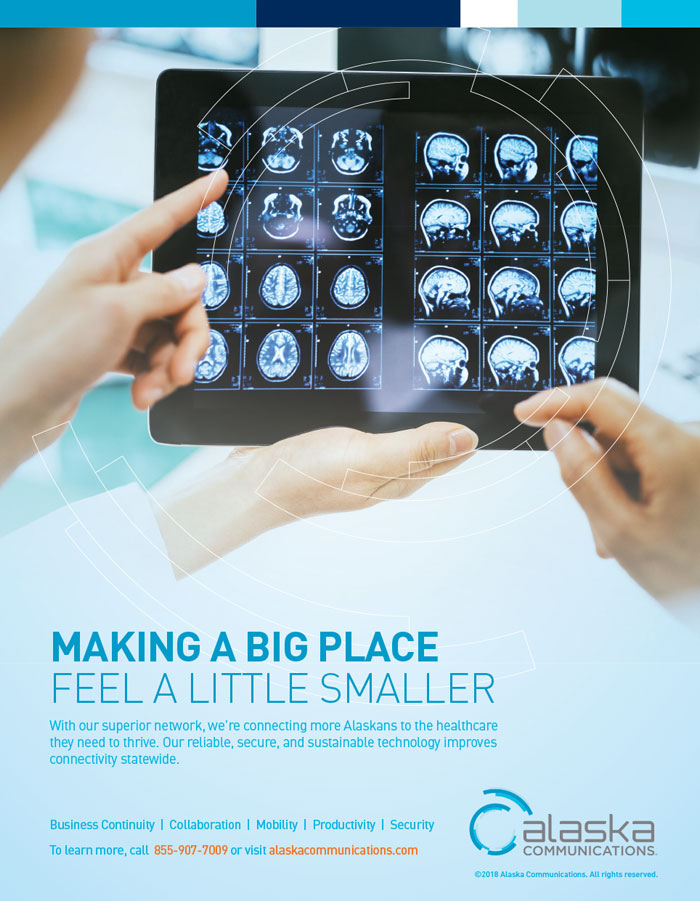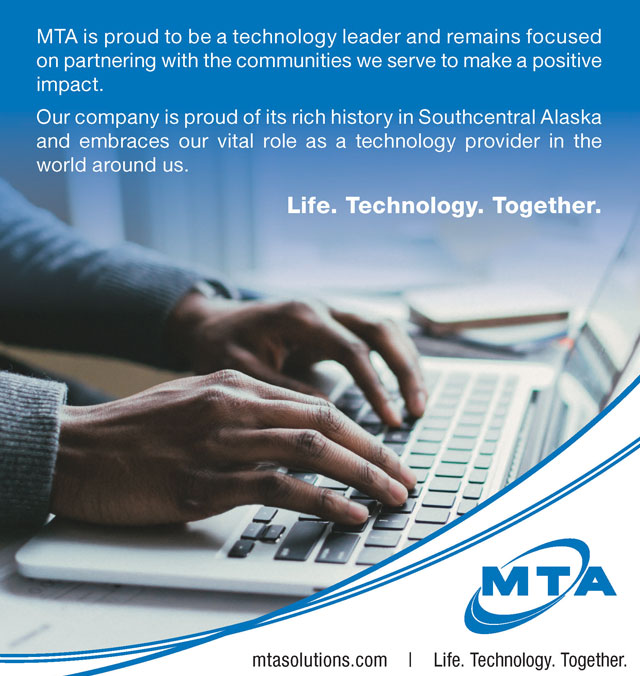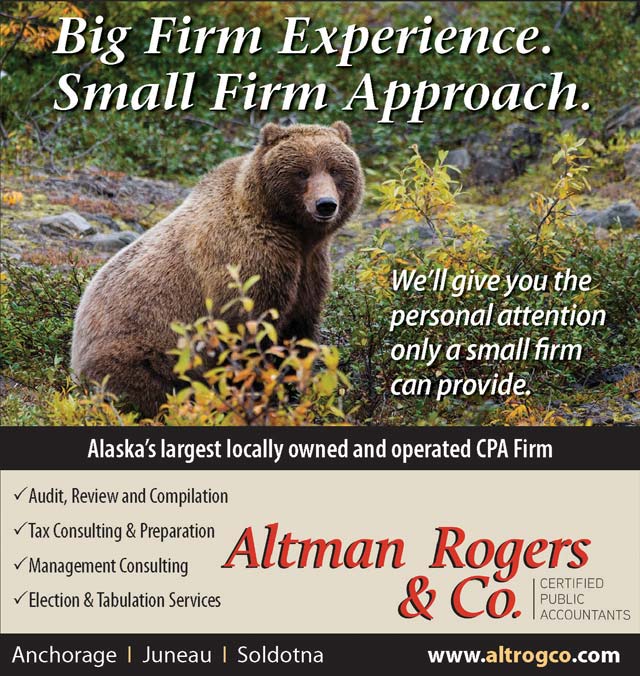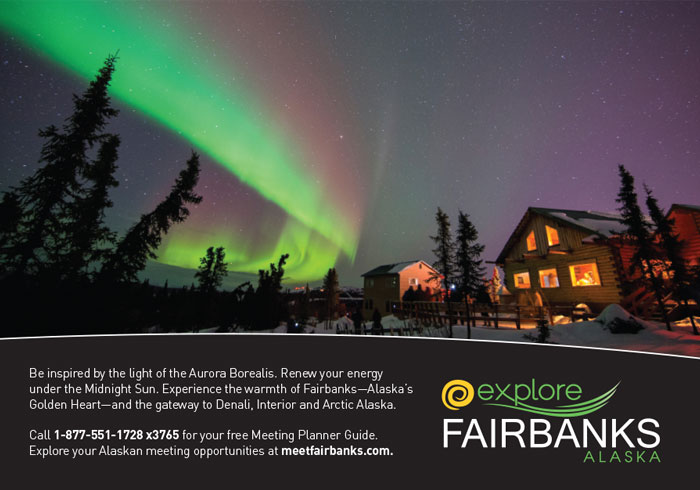December 2018 | Volume 34 | Number 12 | AKBIZMAG.COM
Contents
Features
By Julie Stricker
Expansion, Innovation, and Evolution
By Tracy Barbour
By Tasha Anderson
Behind the Scenes of Heavy Hauls
By Brad Joyal
2019 Convention Calendar: Alaska’s Industry Meetings and Trade Shows
By Sam Friedman
Southeast Alaska Construction Holds Steady
By Vanessa Orr
By Isaac Stone Simonelli
Special Section
By Isaac Stone Simonelli
The Most Stable Industry in Alaska
By Julie Stricker
By Isaac Stone Simonelli

Departments

Volume 34, #12
Published by Alaska Business
Publishing Co. Anchorage, Alaska
Editorial Staff
Managing Editor
Kathryn Mackenzie
257-2907 editor@akbizmag.com
Associate Editor
Tasha Anderson
257-2902 tanderson@akbizmag.com
Digital and Social Media Specialist
Arie Henry
257-2906 ahenry@akbizmag.com
Art Director
David Geiger
257-2916 design@akbizmag.com
Art Production
Linda Shogren
257-2912 production@akbizmag.com
Photo Contributor
Judy Patrick
BUSINESS STAFF
President
Billie Martin
VP & General Manager
Jason Martin
257-2905 jason@akbizmag.com
VP Sales & Marketing
Charles Bell
257-2909 cbell@akbizmag.com
Senior Account Manager
Janis J. Plume
257-2917 janis@akbizmag.com
Advertising Account Manager
Christine Merki
257-2911 cmerki@akbizmag.com
Accounting Manager
Ana Lavagnino
257-2901 accounts@akbizmag.com
Customer Service Representative
Emily Olsen
257-2914 emily@akbizmag.com
501 W. Northern Lights Boulevard,Suite 100 Anchorage, Alaska 99503-2577
Toll Free: 1-800-770-4373
(907) 276-4373
www.akbizmag.com
Press releases: press@akbizmag.com
ALASKA BUSINESS PUBLISHING CO., INC.
Alaska Business (ISSN 8756-4092) is published monthly by Alaska Business Publishing Co., Inc., 501 W. Northern Lights Boulevard, Suite 100, Anchorage, Alaska 99503-2577; Telephone: (907) 276-4373;
© 2018 Alaska Business Publishing Co. All rights reserved. No part of this publication may be reproduced without written permission from the publisher. Alaska Business accepts no responsibility for unsolicited materials; they will not be returned unless accompanied by a stamped, self addressed envelope.
One-year subscription is $39.95 and includes twelve issues (print + digital) and the annual Power List. Single issues of the Power List are $15 each. Single issues of Alaska Business are $3.95 each; $4.95 for the October issue. Send subscription orders and address changes to circulation@akbizmag.com. To order back issues ($8.95 each including postage) visit www.akbizmag.com/store.
From the Editor
A Contentious Election Could Mean a Brighter Future
ast month’s mid-term elections were fraught with tension for most of the nation. Emotions ran high on all sides of the fence. Across the country democrats, republicans, and all parties in between felt they had a lot on the line. It was no different here in Alaska.
One of the most contentious measures Alaskans voted on was Ballot Measure 1 (colloquially known as “Stand for Salmon”). The ballot measure was roundly defeated by about two-to-one, much to the relief of the more than 500 Alaska businesses, trade groups, and organizations that opposed the measure. Ballot Measure 1 called for sweeping—and many say onerous—changes to permitting laws in the name of increasing salmon habitat protections. The measure’s defeat is being celebrated by many industries and the companies within them that have large-scale development projects planned or in progress and who say responsible development and rigorous salmon habitat protection laws are already an intrinsic part of every project.


Kathryn Mackenzie
Managing Editor, Alaska Business
Telecom & Tech
Expansion, Innovation,
and Evolution
The ins and outs
of Internet in Alaska
By Tracy Barbour
oday, many organizations depend heavily on having access to secure and reliable data networks to support their operations. A data network—often referred to as a computer network or simply a network—is a telecommunications network that allows computers to exchange data.
Telecom providers give businesses and consumers access to the exterior and interior equipment they need to transfer data between various points. For example, Advanced Physical Therapy relies on GCI for its Internet and intra-office connection, according to Jesse Berg, the practice’s systems administrator. GCI handles the network connection between the company’s Anchorage location and four other sites in Wasilla, Soldotna, Seward, and Fairbanks.
“Our footprint looks a bit different in Alaska due to the very remote and isolated areas that cannot even be accessed by roads, but the services are typically the same. In fact, Anchorage is one of our 239 5G Evolution markets across the country. 5G Evolution technologies serve as a foundation for our future 5G wireless networking.”
—Shawn Uschmann
Director of External Affairs Alaska, AT&T
Telecom & Tech
Expansion, Innovation,
and Evolution
The ins and outs
of Internet in Alaska
By Tracy Barbour
oday, many organizations depend heavily on having access to secure and reliable data networks to support their operations. A data network—often referred to as a computer network or simply a network—is a telecommunications network that allows computers to exchange data.
Telecom providers give businesses and consumers access to the exterior and interior equipment they need to transfer data between various points. For example, Advanced Physical Therapy relies on GCI for its Internet and intra-office connection, according to Jesse Berg, the practice’s systems administrator. GCI handles the network connection between the company’s Anchorage location and four other sites in Wasilla, Soldotna, Seward, and Fairbanks.
“Our footprint looks a bit different in Alaska due to the very remote and isolated areas that cannot even be accessed by roads, but the services are typically the same. In fact, Anchorage is one of our 239 5G Evolution markets across the country. 5G Evolution technologies serve as a foundation for our future 5G wireless networking.”
—Shawn Uschmann
Director of External Affairs Alaska, AT&T
Advanced Physical Therapy has 150 to 170 devices connected to its network, ranging from laptops and desktops to switches and routers. Almost everything Advanced Physical Therapy does depends on the security and reliability of its data network. For instance, the company’s electronic medical records are hosted in Anchorage, including critical patient schedules. And everything must be compliant with the Health Insurance Portability & Accountability Act (HIPAA), so maintaining reliable and secure access to data is essential. “There is nothing more important than making sure everything on our network is as secure as can be because we deal with such important information,” Berg says.
Energy
An Anchorage residence gains power from the sun through a solar power array.
Arctic Solar Ventures
Same Sun, Superior Science
Better tech makes renewable energy systems more affordable
By Julie Stricker
hen Alex Papasavas started her restaurant, Turkey Red, in Palmer a decade ago, her goal was to locally-source as much meat and produce as she could. Papasavas and her staff of thirty-four make nearly all of their main dishes, desserts, bread, and mozzarella from products grown or raised within the Mat-Su region. “I planned the restaurant to where we reduce our carbon footprint as much as possible,” she says. “The food industry is one of the most polluting industries on our planet because everyone has to eat.”
finance
‘Protect, Detect, Respond’
Keeping clients safe from identity theft
By Tracy Barbour
dentity theft is one of the fastest-growing crimes in America, and it’s the number one complaint reported to the Federal Trade Commission. Personal identity theft involves using another person’s name and other personal information to steal his or her persona and financial security.
Identity thieves often use a stolen Social Security number to open accounts in someone else’s name and make purchases using that person’s good credit. The perpetrators typically have invoices and bills sent to a phony address—generally a post office box number—so unsuspecting victims often don’t discover the crime for years. Usually, identity theft victims become aware of the problem only when they receive bills for goods and services they didn’t buy, notice suspicious bank account withdrawals, or detect new accounts they didn’t open on their credit report.
Oil & Gas
Optimism in Oil
How Alaska’s policies work against, but could work for, its largest industry
By Tasha Anderson
here’s been positive news coming out of Alaska’s onshore and offshore Arctic oil operations. ConocoPhillips Alaska’s Greater Mooses Tooth 1 (GMT1) produced first oil on October 5—ahead of schedule, according to the company. GMT1 is the first drill site on federal leases within NPR-A, with an approximate cost of $725 million and an estimated peak monthly production of 25,000 to 30,000 barrels of oil per day.
ConocoPhillips Alaska also released positive news about Greater Mooses Tooth 2 (GMT2) in northeast NPR-A. On October 17, BLM and US Army Corps of Engaineers released a joint Record of Decision for GMT2, which is anticipated to produce approximately 40,000 barrels of oil per day for an estimated thirty years. ConocoPhillips Alaska approved GMT2 for funding October 25 and is beginning construction in the 2018-2019 winter season, planning for first oil in “late 2021.” The company anticipates investing just under $1 billion on the development. According to ConocoPhillips Alaska, “Both GMT1 and GMT2 will generate new revenue for federal government, the State of Alaska, Native corporations, and the North Slope Borough.”
Offshore, Alaska welcomed the long-awaited news in late October that the Bureau of Ocean Energy Management issued conditional approval to Hilcorp Alaska for its Liberty Project development and production plan. The proposed oil and gas project would entail the construction of a nine-acre artificial gravel island in the Beaufort Sea approximately five miles off the coast.
“The Hilcorp Liberty Project, if completed, will be the first production facility ever located in federal waters off Alaska… American energy dominance is good for the economy, the environment, and our national security. Responsibly developing our resources, in Alaska especially, will allow us to use our energy diplomatically to aid our allies and check our adversaries.”
—Ryan Zinke
US Secretary of the Interior
Oil & Gas
Optimism in Oil
How Alaska’s policies work against, but could work for, its largest industry
By Tasha Anderson
here’s been positive news coming out of Alaska’s onshore and offshore Arctic oil operations. ConocoPhillips Alaska’s Greater Mooses Tooth 1 (GMT1) produced first oil on October 5—ahead of schedule, according to the company. GMT1 is the first drill site on federal leases within NPR-A, with an approximate cost of $725 million and an estimated peak monthly production of 25,000 to 30,000 barrels of oil per day.
ConocoPhillips Alaska also released positive news about Greater Mooses Tooth 2 (GMT2) in northeast NPR-A. On October 17, BLM and US Army Corps of Engaineers released a joint Record of Decision for GMT2, which is anticipated to produce approximately 40,000 barrels of oil per day for an estimated thirty years. ConocoPhillips Alaska approved GMT2 for funding October 25 and is beginning construction in the 2018-2019 winter season, planning for first oil in “late 2021.” The company anticipates investing just under $1 billion on the development. According to ConocoPhillips Alaska, “Both GMT1 and GMT2 will generate new revenue for federal government, the State of Alaska, Native corporations, and the North Slope Borough.”
Offshore, Alaska welcomed the long-awaited news in late October that the Bureau of Ocean Energy Management issued conditional approval to Hilcorp Alaska for its Liberty Project development and production plan. The proposed oil and gas project would entail the construction of a nine-acre artificial gravel island in the Beaufort Sea approximately five miles off the coast.
“The Hilcorp Liberty Project, if completed, will be the first production facility ever located in federal waters off Alaska… American energy dominance is good for the economy, the environment, and our national security. Responsibly developing our resources, in Alaska especially, will allow us to use our energy diplomatically to aid our allies and check our adversaries.”
—Ryan Zinke
US Secretary of the Interior
It’s been a long time coming. The first Liberty exploration well was drilled in 1997 by BP; Hilcorp acquired 50 percent ownership of the Liberty project in 2014; and the companies (with third partner ASRC Exploration) released a draft EIS in August 2017, with the final EIS published in August 2018. It’s anticipated that Liberty could produce 60,000 barrels of oil per day.
In a Hilcorp release about the approval, US Secretary of the Interior Ryan Zinke said, “The Hilcorp Liberty Project, if completed, will be the first production facility ever located in federal waters off Alaska… American energy dominance is good for the economy, the environment, and our national security. Responsibly developing our resources, in Alaska especially, will allow us to use our energy diplomatically to aid our allies and check our adversaries.”
Construction Special Section | Southeast
Southeast Alaska Construction Holds Steady
Completed, ongoing, and upcoming projects
By Vanessa Orr
espite the downturn in Alaska’s economy, construction in Southeast Alaska has held steady. And according to John MacKinnon, executive director, Associated General Contractors of Alaska, that looks to hold true in 2019 as well.
“It’s interesting when you’re looking at the overall Alaska economy how construction in Southeast has remained steady, in part due to the seafood and visitor industries,” he explains. “In the past year, there have been a number of good-sized projects completed, including expansion projects at Kensington Mine and Greens Creek Mine. Right now it looks like 2019 will remain steady, and there might even be some bigger projects put out to bid.”
©Will Mangano | USACE
Construction Special Section | Southeast
Southeast Alaska Construction
Holds Steady
Completed, ongoing, and upcoming projects
By Vanessa Orr
espite the downturn in Alaska’s economy, construction in Southeast Alaska has held steady. And according to John MacKinnon, executive director, Associated General Contractors of Alaska, that looks to hold true in 2019 as well.
“It’s interesting when you’re looking at the overall Alaska economy how construction in Southeast has remained steady, in part due to the seafood and visitor industries,” he explains. “In the past year, there have been a number of good-sized projects completed, including expansion projects at Kensington Mine and Greens Creek Mine. Right now it looks like 2019 will remain steady, and there might even be some bigger projects put out to bid.”
©Will Mangano | USACE
MacKinnon made mention of the Katlian Bay Road project in Sitka, which was proposed in late September. This project, which engineers estimate will run between $10 million and $20 million, would include construction of approximately nine miles of a new, single-lane gravel road, beginning at the end of Halibut Point Road in Sitka and continuing north to its termination within Katlian Bay at the eastern property boundary of Shee Atiká, an ANSCA urban corporation. Work would include the installation of approximately 300 culverts and the construction of two bridges over the South Katlian River and Katlian River.
“I believe this is a segment of a future road connection across the island so that someday the ferry run can be significantly shortened, thus reducing costs and potentially increasing service,” says MacKinnon, noting the success of the day ferry that currently services Metlakatla from Ketchikan and includes a 14.5-mile road route.
Construction Special Section | COMMUNITY PLANNING
Newtok to Mertarvik
How an entire village is being evicted by climate change
By Isaac Stone Simonelli
n October, the Yup’ik community of Newtok braced itself to lose four homes to rapid erosion as storms from the southeast removed dozens of feet of shoreline no longer protected by ice and permafrost due to climate change. During a three-day storm at the beginning of October, twenty feet of shoreline was lost, putting the closest homes within twenty-five feet of the Ningliq River.
“With these October storms and as the rate of erosion grows, the consensus feeling within the community is worried; those closest to the erosion feel the anxiety most, as they witness the effects on a day-to-day basis,” says Andrew John, the Newtok Village Tribal Administrator. “Nearly the entire community feels on edge. I know [I]have had a lot of sleepless nights.
“We as a community have no time for debate over climate change anymore. It’s here: we see it, live it, and currently with these storms that we are having right now, we feel the direct impacts of it.”
ANTHC
Construction Special Section | COMMUNITY PLANNING
Newtok to Mertarvik
How an entire village is being evicted by climate change
By Isaac Stone Simonelli
n October, the Yup’ik community of Newtok braced itself to lose four homes to rapid erosion as storms from the southeast removed dozens of feet of shoreline no longer protected by ice and permafrost due to climate change. During a three-day storm at the beginning of October, twenty feet of shoreline was lost, putting the closest homes within twenty-five feet of the Ningliq River.
“With these October storms and as the rate of erosion grows, the consensus feeling within the community is worried; those closest to the erosion feel the anxiety most, as they witness the effects on a day-to-day basis,” says Andrew John, the Newtok Village Tribal Administrator. “Nearly the entire community feels on edge. I know [I]have had a lot of sleepless nights.
“We as a community have no time for debate over climate change anymore. It’s here: we see it, live it, and currently with these storms that we are having right now, we feel the direct impacts of it.”
ANTHC
Since 1994 the village of about 400 people nestled between the Ningliq River and Newtok River has been working toward fleeing the slow-moving disaster zone, acquiring a new site, Mertarvik (on Nelson Island) in a land trade with the US Fish and Wildlife Service in 2003.
Developing the new site, putting in basic modern infrastructure—running water, power, sewers—is an incredibly costly endeavor made even more difficult by the limited resources and commerce within the community.
Construction Special Section | Warehousing
Construction Special Section | Warehousing
Alaska Structures
Wide Open Spaces
When warehouse space is your best construction bet
By Vanessa Orr
hen you’re standing in line at Costco, you may not think much about the building that you’re in—you’re probably only reflecting on what a bargain you got on your 2,400-count case of paper towels. But what’s interesting about warehouses, other than how massive they can be, is how many unique ways they can be used by different industries.
According to William Hansen, director of marketing for Alaska Structures, there is no limit to a warehouse’s versatility. “Warehouses are used by oil and gas companies as pump station enclosures; by mining companies for onsite warehousing; by the auto industry as manufacturing facilities; by airports as hangars, maintenance and repair facilities, and luggage sorting and handling facilities; and by shipping companies as distribution warehouses,” he says. “Warehouses are perfect for pretty much any industry that requires a large, free-span building.”
Transportation
Transportation
Behind the Scenes of Heavy Hauls
Collaboration and communication get the job done
By Brad Joyal
etween its vast landscapes and underdeveloped or nonexistent road systems, navigating through Alaska can be daunting. Whether driving a four-door sedan or a semitrailer, traversing the 49th state is often a tricky endeavor, especially when hauling heavy loads, an integral aspect of transportation in Alaska that STR Alaska President Curtis Spencer describes as “very challenging.”
Healthcare Special Section | New Construction
Alaska CARES
Alaska Cares building under construction in late October 2018.
© O’Hara Shipe
A safe place for Alaska’s most vulnerable victims
By Isaac Stone Simonelli
ith sexual assault and child abuse cases hitting all-time highs for Alaska CARES Child Advocacy Center and Forensic Nursing Services of Providence in Anchorage, construction is rapidly moving forward on a new multidisciplinary facility in Midtown.
The custom-designed center—which will continue to house detectives from the Anchorage Police Department Crimes Against Children Unit and Special Victims Unit; an investigative unit from the Alaska State Troopers; Office of Children Services; Alaska CARES; and Forensic Nursing—broke ground in February, and it’s anticipated service providers will be settled into their new offices by April 2019.
Healthcare Special Section | Development
The Most Stable Industry in Alaska
Fierce demand increases healthcare construction
By Julie Stricker
ob security is likely not a concern for those working in the healthcare industry, either as caregivers or tangentially constructing healthcare facilities. Even during the worst economic times this sector shows continuous and substantial growth.
“It just grows and it’s been growing relentlessly for a very, very long time,” says state labor economist Neal Fried. “It’s still continuing to do that.”
In the past decade, new healthcare facilities have been built in Alaska’s population centers, as well as hub cities for rural areas such as Nome and Bethel. That trend is continuing, with new construction and upgrades to facilities in Soldotna, Anchorage, Palmer, and Southeast Alaska in the works or planning stages through 2020.
Healthcare Special Section | Development
The Most Stable Industry in Alaska
Fierce demand increases healthcare construction
By Julie Stricker
ob security is likely not a concern for those working in the healthcare industry, either as caregivers or tangentially constructing healthcare facilities. Even during the worst economic times this sector shows continuous and substantial growth.
“It just grows and it’s been growing relentlessly for a very, very long time,” says state labor economist Neal Fried. “It’s still continuing to do that.”
In the past decade, new healthcare facilities have been built in Alaska’s population centers, as well as hub cities for rural areas such as Nome and Bethel. That trend is continuing, with new construction and upgrades to facilities in Soldotna, Anchorage, Palmer, and Southeast Alaska in the works or planning stages through 2020.
Healthcare Development
Healthcare is Alaska’s largest private sector employer. A decade ago, the Alaska healthcare industry employed 27,800 workers. By 2010, that number had grown to 30,200. By August 2018, 38,500 people were employed by the state’s healthcare organizations.
“That’s pretty serious growth,” Fried says. “No other industry is growing that way. There is no other industry that is growing so consistently over time. It’s kind of amazing that it’s that large and it’s growing that rapidly and it’s still on that trajectory of growth.”
Alaska’s largest non-government employer is Providence Health and Services, which operates the state’s largest hospital, Providence Alaska Medical Center in Anchorage, as well as hospitals in Seward, Kodiak, and Valdez.
Healthcare Special Section | Women’s Health
Connecting to Healthcare
Money, time, and limited services increase women’s health risk
By Isaac Stone Simonelli
Three of the greatest barriers of entry for women to access healthcare in Alaska are education, time, and financial restraints—whether perceived or actual.
“First of all, it’s making the time, making it a priority,” says Julie Taylor, CEO of Alaska Regional Hospital. “Second is what is their out of pocket expense going to be? Is their insurance plan going to cover it with very little co-pay or deductible or do they have to pay a $5,000 deductible before they go in and get those things done?”

Healthcare Special Section | Women’s Health
Connecting to Healthcare
Money, time, and limited services increase women’s health risk
By Isaac Stone Simonelli
Three of the greatest barriers of entry for women to access healthcare in Alaska are education, time, and financial restraints—whether perceived or actual.
“First of all, it’s making the time, making it a priority,” says Julie Taylor, CEO of Alaska Regional Hospital. “Second is what is their out of pocket expense going to be? Is their insurance plan going to cover it with very little co-pay or deductible or do they have to pay a $5,000 deductible before they go in and get those things done?”

Medicare | Medicaid
Nonetheless, with Medicare and Medicaid there shouldn’t be as many issues with uninsured or underinsured women accessing certain preventive healthcare services, such as mammograms or cervical cancer screenings, Taylor explains.
“But there are not that many clinics that take Medicare and Medicaid,” she says, noting that Alaska Regional Hospital accepts both programs.
The reason many private practices will only take a limited number of Medicare and Medicaid patients is directly linked to economics.
Meetings & Conventions
2019 Convention Calendar:
Alaska’s Industry Meetings and Trade Shows
Where to meet, greet, and learn all year long
By Sam Friedman
hen it’s time to network, learn, and even pick up some swag, there are a bevy of annual conventions held statewide to inform and entertain. The schedules are out—or at least starting to coalesce—for many of the state’s largest and most anticipated conventions taking place in 2019.
The twenty conferences listed here include some of the main annual events for Alaska’s largest industries and areas of interest: oil and gas, mining, Alaska Native corporations, healthcare, fisheries, telecommunications, transportation, the Arctic, and utilities.
In addition to local conferences, several national industry conferences will come to the 49th State in 2019, including a Chinese tourism convention in March, a large international data analytics convention in August, and the first-ever American meeting of the International Forum of Sovereign Wealth Funds Conference in September.
Travel Juneau
Meetings & Conventions
2019 Convention Calendar: Alaska’s Industry Meetings and Trade Shows
Where to meet, greet, and learn all year long
By Sam Friedman
hen it’s time to network, learn, and even pick up some swag, there are a bevy of annual conventions held statewide to inform and entertain. The schedules are out—or at least starting to coalesce—for many of the state’s largest and most anticipated conventions taking place in 2019.
The twenty conferences listed here include some of the main annual events for Alaska’s largest industries and areas of interest: oil and gas, mining, Alaska Native corporations, healthcare, fisheries, telecommunications, transportation, the Arctic, and utilities.
In addition to local conferences, several national industry conferences will come to the 49th State in 2019, including a Chinese tourism convention in March, a large international data analytics convention in August, and the first-ever American meeting of the International Forum of Sovereign Wealth Funds Conference in September.
Travel Juneau

Alaska Native conventions taking place in 2019 include Southcentral Foundation’s annual gathering in February and the Alaska Federation of Natives annual convention in October.
©Shelly Wozniak
In Anchorage
◼ Meet Alaska Conference and Trade Show from the Alaska Support Industry Alliance is taking place on January 18 from 8 a.m. to 5 p.m. at the Dena’ina Civic and Convention Center.
The Alaska Support Industry Alliance is the trade group for the industries that support Alaska’s oil and gas industries. The Alliance has more than fifty members, including construction, transportation, and banking businesses. All together those fifty member companies employ more than 50,000 people. Admission to the Meet Alaska Convention is $250 for members, $275 for non-members, $100 for legislators, and $200 for other government officials and staff.
http://alaskaalliance.com/

Far North Hotels
Far North Hotels
Arctic Accommodations
laska’s Arctic is a unique and spectacular destination whether one is traveling just to see the sights or to get a job done. No matter your purpose for visiting Alaska’s northern regions, venues abound that provide all the services you need to take in the wildlife, landscape, and local culture in convenient comfort.
Angel Camp by the Sea
Angel Camp by the Sea is a bed and breakfast with two available suites located in Nome on Front Street at the end of the Iditarod. Amenities include free WiFi, continental breakfast, laundry, private entry, and an ocean view. angelcampbythesea.com
Arctic Getaway
The Hicker family operates Arctic Getaway Rental Cabins and Breakfast out of Wiseman, north of Coldfoot along the Dalton Highway. The company offers visitors three furnished, private cabins, each with a kitchenette. Guests are invited into the Hicker home every morning for a hearty, home-cooked breakfast. arcticgetaway.com

Events Calendar
Events Calendar
Anchorage
This is a musical adventure through a bug’s life, perfect for children and families. Is Spider getting too big for his own skin? Will Fly find her superhero powers in time to save her Aunt Rita from peril? Will Worm learn to stand on his own two feet…even though he doesn’t have feet? This heartwarming musical captures all of the droll humor and whimsy of the wildly popular books. cyranos.org
8
Taking place at Cornerstone Church in Anchorage, this bazaar annually celebrates the unique nature of the local Alaskan artist community. In addition to shopping, guests can enjoy food at the concession stand, gourmet coffee, and live music. Admission and parking are free. facebook.com/pg/WonderfullyMadeChristmasBazaar
Fairbanks
2
The Design Alaska Holiday Concert, which sells out every year, features Eduard Zilberkant conducting the Fairbanks Symphony Orchestra, the Fairbanks Symphony Chorus, and the Northland Youth Choir. Guests will be treated to traditional holiday favorites at the C.W. Davis Concert Hall on the UAF campus beginning at 4 p.m. fairbankssymphony.org
Starting at 1 p.m., on the shortest day of the year, walk with a Friends of Creamer’s Field naturalist near the iconic Creamer’s barns. friendsofcreamersfield.org
Business Events
December
December 2-5
ALASBO Annual Conference
Anchorage: Annual conference of the Alaska Association of School Business Officials. alasbo.org
December 7-9
ASGA Annual Conference
Cape Fox Lodge, Ketchikan: The Alaska Shellfish Growers Association conference includes a banquet, movie viewing, and oyster tasting. It also includes the ASGA annual business meeting; a tour of local farms; discussions about oyster and kelp farming regulations; and growing a successful business in the mariculture industry. alaskashellfish.org
January
January 10-12
Alaska Wholesale Gift Show
Dena’ina Center, Anchorage: This event provides an opportunity for small business owners/producers to grow their buyer base, meeting face-to-face with other business owners, buyers, and managers. There are show specials on hotels, car rentals, travel concierges, and more. 10times.com/wholesale-alaskan-gift
January 18
Meet Alaska Conference
Dena’ina Center, Anchorage: Hosted by the Alliance, this is the largest one-day energy conference in Alaska and includes educational forums and a tradeshow. alaskaalliance.com
January 24
Junior Achievement of Alaska Awards Banquet
Dena’ina Center, Anchorage: Four new Alaskans will be inducted and recognized with this prestigious award. Attended by more than 400 business representations, the program consists of a networking reception, dinner, and awards ceremony. juniorachievement.org/web/ja-alaska
January 25-27
Alaska RTI/MTSS Conference
Dena’ina Center, Anchorage: Featured sessions include Mindset Mathematics, Student Engagement and Self-Efficacy, Computational Thinking and Computer Science in the Elementary Classroom, and Collaborative Leadership Collaborative. asdn.org/school-year-conferences-and-institutes
Inside Alaska Business
Northrim Bank
Northrim Bank announced the opening of its newest branch, the Eastside Community Branch, located at 7905 Creekside Center Drive.
The new location updates Northrim’s “branch of the future” blueprint used in the design of its Lake Otis Community Branch, opened in 2015, with a focus on customer interaction in a more efficient footprint. The streamlined design continues the bank’s focus on personalized service. northrim.com
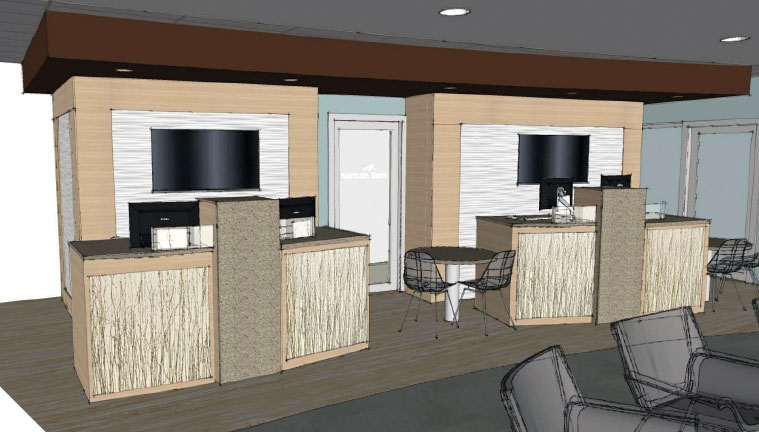
Goodwill Industries
Goodwill Industries of Alaska opened a new retail store at 8931 Old Seward Highway in Anchorage.
The store opening means that Goodwill Industries, an organization in existence since 1902, now has a second retail presence in the state. The store is stocked with clothing, books, shoes, housewares, and more. goodwill-alaska.org
Right Moves
Bettisworth North

Kelly
 Bettisworth North Architects and Planners selected Colleen Kelly as its new Director of Marketing and Business Development. Kelly has a decade of experience in communication, marketing, and business development. She holds dual bachelor’s in journalism and public communications and French language from UAA and is nearing completion of a master’s degree in technical communication from Minnesota State University.
Bettisworth North Architects and Planners selected Colleen Kelly as its new Director of Marketing and Business Development. Kelly has a decade of experience in communication, marketing, and business development. She holds dual bachelor’s in journalism and public communications and French language from UAA and is nearing completion of a master’s degree in technical communication from Minnesota State University.
Simon & Seafort’s

Alger
 Rachelle Alger joined Simon & Seafort’s as the Event and Marketing Manager. She will oversee all facets of events booked in Room 49, Simon’s private dining room, and restaurant promotional activities. Alger received her master certification in contract administration from George Washington University.
Rachelle Alger joined Simon & Seafort’s as the Event and Marketing Manager. She will oversee all facets of events booked in Room 49, Simon’s private dining room, and restaurant promotional activities. Alger received her master certification in contract administration from George Washington University.
At a Glance
What book is currently on your nightstand?
I am an Audible.com fan so my nightstand is empty, but I have a list of
audiobooks by my favorite authors Jodi Picoult and Simon Sinek.
What movie do you recommend to everyone you know?
For lighthearted fun, I am a huge fan of the “Pitch Perfect” series. My daughter and I have been watching them together over the years.
What’s the first thing you do when you get home after a long day at work?
In winter, I change right into my pajamas. In summer, I put on my tennis shoes.
If you couldn’t live in Alaska what’s your dream locale?
Anywhere in Italy! I traveled there in 2017 with my sister and loved every minute of it.
At a Glance
What book is currently on your nightstand?
I am an Audible.com fan so my nightstand is empty, but I have a list of
audiobooks by my favorite authors Jodi Picoult and Simon Sinek.
What movie do you recommend to everyone you know?
For lighthearted fun, I am a huge fan of the “Pitch Perfect” series. My daughter and I have been watching them together over the years.
What’s the first thing you do when you get home after a long day at work?
In winter, I change right into my pajamas. In summer, I put on my tennis shoes.
If you couldn’t live in Alaska what’s your dream locale?
Anywhere in Italy! I traveled there in 2017 with my sister and loved every minute of it.
Off the Cuff
Julie Taylor
ulie Taylor joined Alaska Regional Hospital as CEO five years ago in December 2013. Throughout her career Taylor has held a number of leadership positions including director of case management and admissions, interim vice president of human resources, associate chief nursing officer, and chief operating officer. Taylor is a Fellow in the American College of Healthcare Executives as well as a registered nurse. She lives in Anchorage with her husband Mike and their daughter Lauren.
Alaska Trends
Healthy Careers in Medicine
ealthcare is Alaska’s fastest growing industry. The growth of this industry has contributed to new jobs as well as new or expanded medical facilities and services statewide. Incomes for various healthcare industry positions vary, though generally they run from mid-range to high income. And many of the mid-range positions do not require arduous amounts of certification, training, or education, creating opportunities for industrious and competent individuals to become qualified and begin providing care relatively quickly. Below Alaska Business has gathered Mid-2017 State Occupational Employment and Wage Estimates-Alaska data from the US Bureau of Labor Statistics that show the number of Alaskans employed in various healthcare industry positions and their mean annual and hourly wage.

680
Medical Records and Health Information Technicians
making on average $26.04 hourly and $54,170 annually

390
Psychiatric Technicians
making on average $17.91 hourly and $37,260 annually
Advertisers Index

Thanks for reading our December 2018 issue!




